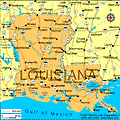 History Louisiana has a rich, colorful historical background. Early Spanish explorers were Alvárez Piñeda, 1519; Álvar Núñez Cabeza de Vaca, 1528; and Hernando de Soto in 1541. Sieur de la Salle reached the mouth of the Mississippi and claimed all the land drained by it and its tributaries for Louis XIV of France in 1682. Louisiana became a French crown colony in 1731 but was ceded to Spain in 1763 after the French and Indian Wars. (The portion east of the Mississippi came under British control in 1764.) Louisiana reverted to France in 1800 and was sold by Napoleon to the U.S. in 1803. The southern part, known as the territory of Orleans, became the state of Louisiana in 1812. During the Civil War, Louisiana joined the Confederacy, but New Orleans was captured by Union Adm. David Farragut in April 1862. The state's economy suffered during Reconstruction; however, the situation improved at the turn of the 20th century, with the discovery of oil and natural gas and the growth of industry. Louisiana is a leader in natural gas, salt, petroleum, and sulfur production. Much of the oil and sulfur comes from offshore deposits. The state also produces large crops of sweet potatoes, rice, sugar cane, pecans, soybeans, corn, and cotton. Leading manufactured items include chemicals, processed food, petroleum and coal products, paper, lumber and wood products, transportation equipment, and apparel. The state has become a popular tourist destination. New Orleans is the major draw, known particularly for its picturesque French Quarter and the annual Mardi Gras celebration, held since 1838. Other major points of interest include the Superdome in New Orleans, historic plantation homes near Natchitoches and New Iberia, Cajun country in the Mississippi Delta Region, Chalmette National Historic Park, and the state capital at Baton Rouge. On Aug. 29, 2005, Louisiana was hit by Hurricane Katrina, devastating New Orleans, and killing hundreds elsewhere in the state, particularly in the parishes of Jefferson and St. Bernard. Federal and local officials were widely criticized for their slow and inadequate response to the initial disaster and subsequent recovery programs. |
Read this profile of Louisiana to learn about the state's history, points of interest, and government. Also find interesting facts about each state, including the state's motto, symbols, and when it entered the union.




